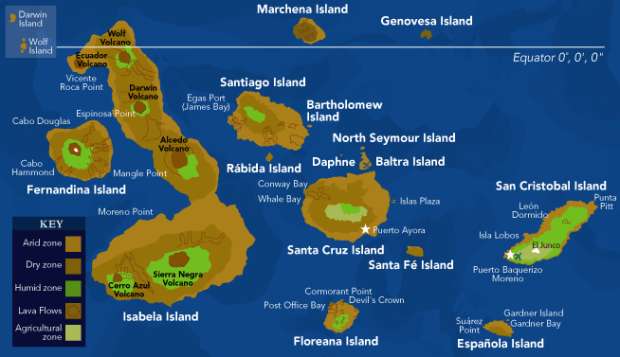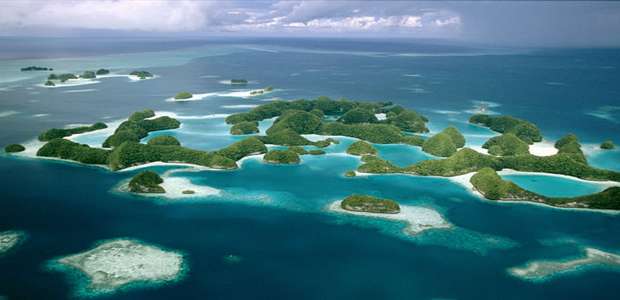A five-week visit to this lonely group of Pacific islands by Charles Darwin changed human understanding by providing a solution to the most crucial question in biological science: how did species originate? An isolated group of islands in the Pacific Ocean has become synonymous with the name Charles Darwin and the word ‘evolution’. In fact, Darwin spent only five weeks on the islands, but those weeks were the culmination of a voyage around the coasts of South America, including periods ashore, during which he had become convinced of the truth of his theory of evolution. Over a period of 20 years, he returned time and again to the written notes of observations he had made in the islands before he fully appreciated that those weeks had given him the hey to how evolution worked: by natural selection.
In 1831, when Darwin boarded HMS Beagle as official naturalist, the accepted opinion in the Christian world was that God had created the planet and everything on it, more or less as it then existed. With the publication of ‘On the Origin of Species by Means of natural selection’ in 1859, Darwin showed that view to be wrong. The first edition of 1250 copies of On the Origin of Species sold out in a day, but Darwin’s conclusions were not universally popular and prompted savage cartoons.
The voyage of the Beagle gave Darwin an opportunity to study a wide variety of terrain and an incredible diversity of plants, animals and birds. And, unlike other scientists and observers he had the chance to witness them at first hand, rather than from books and museum specimens. The three years of the trip convinced him that species did not remain unchanged, but ‘transmuted’ over time. The first crucial pieces of evidence for this were fossils, which proved that some species had died out. Darwin could not accept the explanation that the Creator ‘wiped out’ those creatures that had served their purpose and replaced them with higher beings, of which humans were the ultimate example. For one thing, many of the fossils and bones he unearthed in the course of his trips ashore seemed to be of creatures that were very like those he saw around him, but larger.
The Beagle reached the Galapagos Islands in September 1835. The 19 islands and their associated rocks and islets of volcanic lava are scattered over an area of some 23,000 sq. miles (59,500km) of ocean, and are situated more than 600 miles (1000km) from the South American mainland.
Only five of the Galapagos Islands are today inhabited by humans, some 18,000 in all. The rest, like Bartolome, provide havens for wildlife. All the islands are volcanic in origin, consisting of peaks of lava thrust up from the ocean bed in the last two million years. The ruggedness of the landscape is accentuated by high rocks and volcanic craters, many of which are still active and have erupted in the past century.

Darwin was initially puzzled that any wildlife had become established on such unpromising and isolated terrain. He also remarked that most of the creatures on the islands were unique to the Galapagos, although almost all bore some resemblance to those he had observed on the South American mainland, with local variations.
The range of creatures on the islands was also curious. At the time of Darwin’s visit there were only two mammals in the Galapagos: mice, which he decided had evolved hre, and rats, which probably came on a ship. (In fact seven species of rodent and two of bat are indigenous to the islands). There were no amphibians, but reptiles existed in profusion.
The range of creatures and their similarity to South American species, Darwin eventually concluded, was due to the way all living things reached the islands. The first organisms to colonize the rocky islands were plants, their seeds and spores carried by wind and water. (Darwin kept seeds in water for months, the tried – successfully – to germinate them). Once a stable plant environment existed, animal settlers could gain a foothold. All animal life on the Galapagos Islands – except those species introduced by humans – has evolved from accidental ‘pioneers’. Winged creatures, like the birds, bats and some of the insects, must have flown in from the South American mainland (or been blown off course by strong winds during their annual migrations), hence their similarity to those Darwin had already observed.
All other creatures evolved from individuals which were carried on logs, rafts of vegetation or flood debris initially washed out to sea through river estuaries, then carried on the current to the islands. Soft-structured frog and toad spawn could not have survived such a long saltwater crossing, and even if they had travelled on a raft of sea-weed or other vegetation, the arid islands could not have provided the fresh water they require. Reptile eggs, by contrast, are protected by tough shells that are less likely to be damaged as they drift with the currents.
Probably the most dramatic reptiles were the giant tortoises (after which the islands are named: Galapago is Spanish for tortoise). In Darwin’s day the islands sheltered hundreds of thousands of these creatures. In the absence of carnivorous predators, they can grow to more than 4ft (1.3m) in length weigh up to 395lb (185kg), and live for well over 100 years. Not only did the tortoises reach the islands – probably as eggs or hatchlings – in sufficient numbers to establish a breeding colony, they also spread throughout the islands. The vice-governor of the Galapagos told Darwin that he could tell from which island a tortoise had come, simply by looking at it. Darwin noted this claim, but did not at that time appreciate its significance.
The subtle differences between the tortoises seemed to be governed by local conditions. On those islands where water and vegetation were plentiful, the tortoises cut grasses close to the ground, so the fronts of their shells formed a shallow curve over the neck. In other areas, where they had to reach high for food, their necks were long and their shells curved upwards at the front like a saddle.

The iguanas showed a similar diversity. There were two distinct species on the islands, which Darwin felt must have had the same ancestor, but which had developed along different lines, again presumably to take advantage of available food stocks. Land iguanas eat cactus buds and pips; marine iguanas have evolved long muscular tails that help them to swim out to sea and dive as much as 35ft (11m) to feed off algae growing on underwater rocks.
The reptiles gave Darwin a series of observations which supported the conclusions he finally drew from his studies of the wealth of bird life, in particular the variety of finches. The Galapagos finches provided the evolutionary key: natural selection or the survival of the fittest (the phrase, used by Darwin, was in fact proposed by his contemporary, the British philosopher and sociologist Herbert Spencer). Darwin conjectured (correctly) that “…from an original paucity of birds…one species had been taken and modified for different ends”. The finch is the only land bird in the Galapagos and, in the absence of competition and predators, it evolved to fill every available environment. Each island had its own population of finches that had developed the characteristics that gave them their best chance of survival. Those characteristics were passed on to the next generation, and any creature that did not adapt was doomed to extinction.

The proliferation of species of finch, tortoise and iguana is repeated in the shellfish, seabirds and lizards: the population on each island is different and the differences are recognizable. This fact, Darwin wrote in his journal, “strikes me with wonder”. His genius was to construct from this a viable hypothesis that would offer a plausible explanation of the workings of the natural world.



































